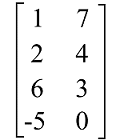Rectangular matrix in Discrete mathematicsA matrix will be known as a rectangular matrix if it is rectangular in shape. We have learned that the elements are arranged in the form of rows and columns in a matrix. A matrix will be called a rectangular matrix if the number of rows and the number of columns are not similar to each other. In this section, we are going to learn about the rectangular matrices, their definition, examples, properties, and operations on the rectangular matrices. What is Rectangular matrixIf the number of rows and the number of columns are not similar to each other or different, only then the matrix will be rectangular. The rectangular matrix is a type of matrix. In case of geometry, rectangular is used to show a quadrilateral in which the length and its width will not be similar to each other or different. In the same way, in case of discrete mathematics, the number of rows and the number of columns of a rectangular matrix will not be similar to each other. Because of this reason, it is named "rectangular". In the following image, there is a rectangular matrix of order m*n where m is used to indicate the number of rows and n is used to indicate the number of columns. 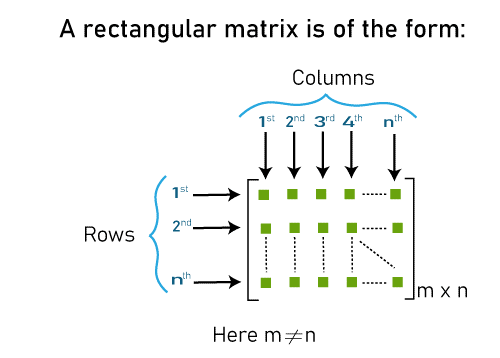
Examples of Rectangular matrixThere are a lot of examples of rectangular matrices, and some of them are described as follows:
[6 3 8 2] In all the above examples of rectangular matrices, the number of rows and the number of columns are not similar to each other. Types of Rectangular matrixIn any matrix, if the number of rows and the number of columns are not similar to each other or different, only then we can get the rectangle shape. If the number of rows is indicated by m, and the number of columns is indicated by n, then we will get the rectangle matrix if m ≠ n. Therefore, we can form a rectangular matrix with the help of two possible cases. The first one is "number of rows is greater than the number of columns (m > n)", and the second one is "number of rows is less than the number of columns (m > n)". In other words, The rectangular matrix is used to contain two types, which are described as follows:
Now we will show some examples of each type of rectangular matrix. These examples are used to contain rectangular matrices. In each matrix, we can see that the number of rows and the number of columns are not similar to each other. The example of a rectangular matrix with rows less than columns are described as follows: 
In this example, we can see that there are 2 number of rows and 4 number of columns. So the number of rows and the number of columns are not similar to each other (2 ≠ 4), but we can see that the number of rows is less than the number of columns (2 < 4). Because of this reason, we will be able to form the rectangular shape in this matrix. Therefore, this is the main reason for forming a rectangular shape. Hence we can say that this matrix is a rectangular matrix. The example of a rectangular matrix with rows more than columns is described as follows: 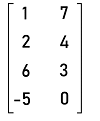
In this example, we can see that there are 4 number of rows and 2 number of columns. So the number of rows and the number of columns are not similar to each other (4 ≠ 2), but we can see that the number of rows is greater than the number of columns (4 > 2). Because of this reason, we will be able to form the rectangular shape in this matrix. Therefore, this is the actual reason for forming a rectangular shape. Hence we can say that this matrix is a rectangular matrix. Operations on Rectangular matrixWe cannot perform all types of matrix operations on rectangular matrices. We can only perform some of them on the rectangular matrices with some limitations. These operations are described as follows: Addition and Subtraction of Rectangular matricesIf the order of the given matrices is the same, only then we can perform the addition and subtraction of rectangular matrices. These operations can be performed on two or more than two matrices. The examples of addition and subtraction of rectangular matrices are described as follows: 
In the above example, we can see that the first matrix contains the order 2*3 and the second matrix contain the order 2*4. So these matrices do not contain the same order. That's why the addition of these matrices will not be possible. 
In the above example, we can see that the first matrix and second matrix contain the order 2*3. So these matrices contain the same order. That's why we can do the subtraction of these matrices. Multiplication of Rectangular matricesIf we are able to satisfy the condition of matrix multiplication, only then we can perform the multiplication of two rectangular matrices, A and B, i.e., the number of columns of A and the number of rows of B must be similar to each other. In other words, we can say that the multiplication of matrices A and B will be possible if A contains the order m*n and B contains the order n*p. In this case, the multiplication of two rectangular matrices, A and B will be in the order m*p. The examples of multiplication operations on rectangular matrices are described as follows: 
In the above example, we can see that the number of columns in the first matrix is 3, and the number of rows in the second matrix is 2, which are not similar to each other. That's why the multiplication of these matrices will not be possible. 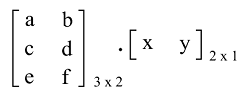
In the above example, we can see that the number of columns in the first matrix is 2, and the number of rows in the second matrix is 2, which are similar to each other. That's why the multiplication of these matrices is possible. Note: It is not necessary that we will get a rectangular matrix as the result of multiplication of two rectangular matrices. For example: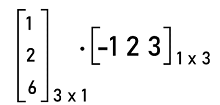
In this example, the first matrix is in the order 3*1, and the second matrix is in the order 1*3. So the multiplication of these matrices will be in the order 3*3, which is a square matrix. Transpose of Rectangular matrixIf we write the rows as columns and the columns as rows, only then we can get the transpose of a matrix. Suppose we have a rectangular matrix with an order m*n, then the transpose of this matrix will also be a rectangular matrix with an order n*m. For example: Let there is a rectangular matrix A which is described as follows: 
The transpose of this matrix is described as follows: 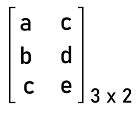
So we can say that the rectangular matrix and its transpose will never be similar to each other. Hence it will never be symmetric. Properties of Rectangular matrixOn the basis of the definition of a rectangular matrix, we can describe some properties of a rectangular matrix, which are described as follows:
Next TopicRow matrix in Discrete mathematics
|
 For Videos Join Our Youtube Channel: Join Now
For Videos Join Our Youtube Channel: Join Now
Feedback
- Send your Feedback to [email protected]
Help Others, Please Share





